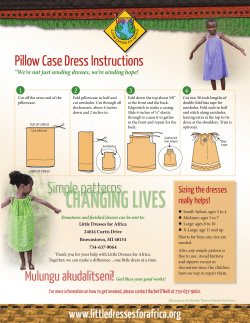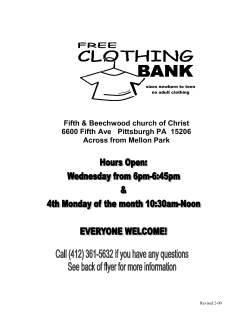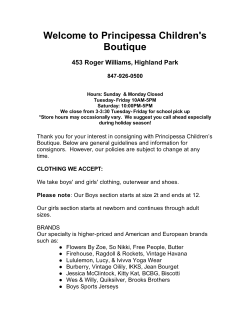
Business Casual Attire
Business Casual Attire For All Marketing Courses above MKT 230, All BTE courses BTE 260 and above. The Department of Marketing's objective in establishing a dress code is to enable students to project a professional image while still experiencing the comfort advantages of more casual and relaxed clothing. Not all casual clothing is suitable for the classroom, so these guidelines will help you determine what is appropriate to wear. Clothing that works well for the beach, yard work, dance clubs, exercise sessions, and sports contests are not appropriate for a professional appearance. Below is a general overview of what we mean by “acceptable business casual attire.” Items that are not appropriate for the classroom are listed, too. Neither list is all-inclusive and both are open to change. The lists tell you what is generally acceptable as business casual attire and what is generally not acceptable as business casual attire. No dress code can cover all contingencies so students must apply a certain amount of judgment in their choice of clothing to wear to Department of Marketing classes. If you experience uncertainty about acceptable, professional business casual attire for your class, please ask your professor or stop by the Marketing office (352 COB Building) to discuss this with the department chairperson. Clothing should be pressed and never wrinkled. Torn, dirty, or frayed clothing is unacceptable. All seams must be finished. Any clothing that has words, terms, or pictures that may be offensive and/or create a hostile environment for other students is unacceptable. A general guideline for business casual attire for women includes: • • • Khaki, corduroy, twill or cotton pants or skirts, neatly pressed; Sweaters, twinsets, cardigans, polo/knit shirts, tailored blouses; Solid colors work better than bright patterns. A general guideline for business casual attire for men includes: • • • Khaki, gabardine or cotton pants, neatly pressed; Cotton long-sleeved button-down shirts, pressed, polo shirts, knit shirts with a collar; Sweaters. More specific information for business casual attire can be found below. Slacks, Pants, and Suit Pants Slacks that are similar to Dockers and other makers of cotton or synthetic material pants, wool pants, flannel pants, and nice looking dress synthetic pants are acceptable. Inappropriate slacks or pants include cargo pants, jeans, sweatpants, exercise pants, short shorts, shorts, Bermuda shorts, bib overalls, leggings, and any spandex or other form-fitting pants such as bike clothing. Skirts, Dresses, and Skirted Suits Casual dresses and skirts, and skirts that are split at or below the knee are acceptable. Dress and skirt length should be no shorter than four inches above the knee, or a length at which you can sit comfortably in public. Short, tight skirts that ride halfway up the thigh are inappropriate for the classroom. Mini-skirts, skorts, sun dresses, beach dresses, and spaghetti-strap dresses are inappropriate for the classroom. Clothing that reveals excessive cleavage, back, chest, stomach or undergarments is not appropriate for a professional classroom setting. Shirts, Tops, Blouses, and Jackets Casual shirts (e.g. a short-sleeved, button-down shirt), golf shirts, dress shirts, sweaters, tops, and turtlenecks are acceptable. Most suit jackets or sport jackets are also acceptable attire for the classroom, if they violate none of the listed guidelines. Inappropriate attire includes tank tops, sweatshirts, midriff tops, shirts with potentially offensive words, terms, logos, pictures, cartoons, or slogans, halter-tops, tops with bare shoulders, and t-shirts unless worn under another blouse, shirt, jacket, or jumper. Use common sense when wearing clothing that has words on it; people are easily offended or distracted by words. Clothing that has the Illinois State University logo is encouraged. Sports team, university, and fashion brand names on clothing are generally acceptable. Footwear and belts Loafers, boots, flats, clogs, dress heels, and leather deck shoes are acceptable. Wearing no stockings is acceptable if the look is appropriate to the outfit. Athletic shoes, flip-flops, slippers, and any shoe that is not appropriate for business are not acceptable for class. As a general rule, belts and shoes that are all-leather are the typical standard for business casual attire. Jewelry, Makeup, Perfume, Cologne, Body Piercing, and Tattoos Any jewelry, makeup, perfume and/or cologne you wear should be in good taste. Do be aware that as you move into the corporate world, visible body piercing other than pierced ears and visible tattoos may not be considered appropriate by some of the firms you want to work for. Hats and Head Covering Hats are not appropriate in the classroom. Head covers that are required for religious purposes or to honor cultural tradition are allowed. Conclusion If clothing fails to meet these standards, as determined by the faculty member and departmental chairperson, a reduction of up to 10% of the grade earned by the student in that Department of Marketing course may result. Below are several websites that were used in the development of the business casual dress policy. http://humanresources.about.com/od/workrelationships/a/dress_code.htm htt p://jobsearch.about.com/od/interviewsnetworking/a/businesscasual.htm http:/ /www.casualpower.com/business_casual_tips/biz_attire.html http://www.business.missouri.edu/Career+Services/Resources/Dress+&+Etiquette/What +is+Business+Casual/default.aspx
© Copyright 2025





















